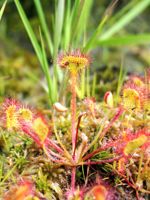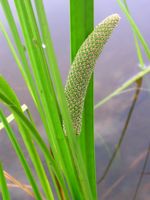Mon-Fri 9am - 5pm Mountain time
American Sweet Flag vs Round-Leaved Sundew
Drosera rotundifolia
Acorus americanus
CUSTOM GROW
CUSTOM GROW
Round-Leaved Sundew is a native carnivorous plant, easily recognized by its bright green leaves covered in distinctive red, glandular hairs. These hairs secrete a sticky substance that is used to attract, trap, and digest insects. Their carnivorous nature allows them to survive in nutrient-poor, acidic soils where many other plants may struggle to grow.
They produce small white flowers that grow along the top of a slender, leafless stem. They can be found growing in wetlands, most often among sphagnum moss, in consistently moist, acidic soils. It does best in cooler summer climates and is intolerant of shade. Due to its small size, the plant can be difficult to spot in its natural habitat. Round-Leaved Sundew is an indicator of healthy wetland systems and is valued in ecological restoration and conservation projects.
American Sweet Flag is a native perennial wetland plant found along shorelines, streams, wet meadows, and marshes. Its extensive rhizome system allows it to spread and stabilise soil, helping maintain the edges of ponds and streams. This dense growth provides cover for small animals and supports overall wetland biodiversity, while the rhizomes and seeds serve as food for small mammals and waterfowl. Cold-hardy and resilient, it is well-suited for ecological restoration, riparian plantings, erosion control, and naturalization projects.
The plant grows in dense clumps with tall, sword-shaped leaves that release a citrus-like scent when bruised. The rhizomes are aromatic, with a spicy, cinnamon-like fragrance that has been used in perfumery and flavouring. In early summer, American Sweet Flag produces a distinctive floral spike (spadix), adding visual interest to wetland plantings.

